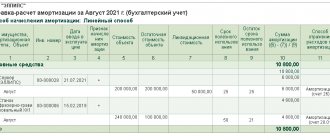Restoring fixed assets has always required careful attention to cost allocation. In some cases, costs had to be attributed to the initial cost of fixed assets, in others - to other expenses. In 2022, additional difficulties will be added to this due to the introduction of new standards for accounting for fixed assets and capital investments. The article contains a comparison of the organization’s actions within the framework of the old and new rules, practical examples of cost distribution in different cases of restoration of fixed assets.
INTRODUCTORY PART
Restoration of a fixed asset object ( FPE ) can be carried out through reconstruction, retrofitting, modernization and repair.
Reconstruction is a change in the parameters of fixed assets, their parts (height, number of floors, area, production capacity indicators, volume) and the quality of engineering and technical support.
Modernization is a set of works to improve an object of fixed assets, increase the technical level and economic characteristics of the object by replacing its structural elements and systems with more efficient ones.
Retrofitting is the addition of fixed assets with new parts, parts and other mechanisms that will form a single whole with this equipment, give it new additional functions or change performance indicators. Their separate use will be impossible.
Repair is a complex of repair, construction, repair and restoration work performed for:
- troubleshooting (restoring operability) of fixed assets;
- maintaining the technical, economic and operational indicators of objects (useful life, power, quality of use, number and area of objects, throughput, etc.) at the initially envisaged level;
- carrying out non-major redevelopment of premises, etc.
Reconstruction, retrofitting and modernization lead to an increase in the cost of fixed assets ; repairs do not increase the cost of fixed assets (Articles 257, 260 of the Tax Code of the Russian Federation, hereinafter referred to as the Tax Code of the Russian Federation).
CHANGES IN LEGISLATION: ACCOUNTING FOR CAPITAL INVESTMENTS ACCORDING TO NEW RULES
Order of the Ministry of Finance of Russia dated September 17, 2020 No. 204n approved new federal accounting standards FSBU 6/2020 “Fixed assets” and FSBU 26/2020 “Capital investments”. In this regard, on 01/01/2022 the following currently valid regulatory documents on fixed assets become invalid:
- Order of the Ministry of Finance of Russia dated March 30, 2001 No. 26n (as amended on May 16, 2016) “On approval of the accounting regulations “Accounting for fixed assets” PBU 6/01” (hereinafter referred to as Order No. 26n);
- Order of the Ministry of Finance of Russia dated October 13, 2003 No. 91n (as amended on December 24, 2010) “On approval of the Guidelines for accounting of fixed assets” (hereinafter referred to as Order No. 91n).
New standards (FSBU 6/2020 and FSBU 26/2020) are applied starting from the accounting (financial) statements for 2022, however, an organization can decide to apply the new rules before the specified date, that is, from 01/01/2021.
FOR YOUR INFORMATION
According to FAS 6/2020, the initial cost of a fixed asset item increases by the amount of capital investments associated with the improvement and (or) restoration of this facility.
Previously, according to PBU 6/01 (clause 14), changes in the initial cost of fixed assets at which they were accepted for accounting were allowed in cases of completion, additional equipment, reconstruction, modernization, partial liquidation and revaluation of fixed assets.
KOSGU: major renovation 2022
When assigning expenses to the relevant items of KOSGU, budgetary enterprises are guided by orders of the Ministry of Finance of the Russian Federation No. 85n dated June 6, 2019 and No. 209n dated November 29, 2017.
As a rule, the cost of both current and major repair work is fixed in subarticle 225 “Works, services for property maintenance” of KOSGU. But it should be remembered: if, as a result of major repair work, the cost of the object has changed or a new OS has been built, then the costs of such changes are taken into account in subarticle KOSGU 228 “Services, work for capital investment purposes,” which generates expenses that subsequently form or increase the cost of the OS.
By the way, the costs of paying for contracts for reconstruction and modernization of the operating system are included in KOSGU article 310 “Increasing the cost of the operating system,” but this is no longer a major overhaul.
Thus, the overhaul of KOSGU is reflected in subarticle 225. A comparable type of cost is KVR 243 “Purchase of goods, services, work for the purpose of overhaul of state and municipal property.” The specified codes identify the costs of major repairs of property or its restoration, i.e. performing certain work related to major repairs or restoration, as well as transferring the results of this work to the government customer. According to KVR 243, within the framework of major repairs (KOSGU 225), work on the repair of the building and premises in it, roofing, window units, communication systems, landscaping, etc. can be included.
To correctly record costs, you should take into account the type of repair work being carried out, i.e. it must be clearly defined in the contract.
WHAT APPLIES TO CAPITAL INVESTMENTS ACCORDING TO FSB 26/2020
FSBU 26/2020 “Capital Investments” establishes requirements for the formation in accounting of information on capital investments of organizations.
It should be noted that the standard dedicated to accounting for capital investments was adopted for the first time. It does not cancel the Regulation on Accounting for Long-Term Investments dated December 30, 1993 No. 160 (hereinafter referred to as Regulation No. 160), which can be applied to the extent that does not contradict the standard.
Capital investments are understood as the organization's expenses for the acquisition, creation, improvement and (or) restoration of fixed assets. Capital investments include, in particular, costs for:
- acquisition of property intended for use directly as fixed assets or parts thereof, or for use in the process of acquisition, creation, improvement and (or) restoration of fixed assets;
- construction, construction, production of fixed assets;
- radical improvement of land;
- preparation of design, working and organizational-technological documentation (architectural projects, construction permits, etc.);
- organization of a construction site;
- implementation of designer's supervision;
- improvement and (or) restoration of fixed assets (for example, completion , retrofitting , modernization , reconstruction , replacement of parts , technical inspections , maintenance );
- delivery and bringing the object into a condition and location in which it is suitable for use for the intended purposes, including its installation, installation;
- carrying out commissioning and testing.
Capital investments are recognized in accounting if the following conditions are simultaneously met:
- the costs incurred will ensure that the organization receives future economic benefits (the non-profit organization achieves the goals for which it was created) for a period of more than 12 months or a normal operating cycle of more than 12 months;
- the amount of costs incurred or an amount equivalent to it is determined.
Information message of the Ministry of Finance of Russia dated November 3, 2020 No. IS-accounting-28 “New in accounting legislation: facts and comments” contains some comments on the application of legislative innovations.
Construction and installation work: accounting features and differences during major repairs and modernization
If it is necessary to carry out construction work for the overhaul of buildings and structures, specialists and accountants have many questions: what types of work can be carried out as part of the overhaul and which ones relate to modernization, what is the necessary algorithm of actions in both cases and how to correctly reflect the costs of these works in accounting. This material will help you understand these issues and more.
1. How to determine what type of work construction work is classified as
During the operation of fixed assets, including buildings and structures, they wear out and lose their original properties to varying degrees. This requires restoration and repair work, as a result of which their characteristics may change. General features of work and criteria for changing the characteristics of objects as a result of their implementation are given in Appendix 5 to Instruction No. 37/18/6.
As for construction activities, it is necessary to determine what type of work to be carried out (current or major repairs, reconstruction or modernization) at the planning stage. The correct definition of the construction project and the composition of the necessary documentation (if necessary, permitting, pre-project and design documentation) depend on this.
At the initial stage, a budgetary organization must proceed from the reason for the need to carry out construction work, its types and the changes that should occur upon completion of its implementation. In cases where buildings and structures require significant repairs, most often budgetary organizations resort to such types of construction work as major repairs or modernization.
Law N 300-Z defines capital repairs as a set of works to restore the technical, operational and consumer qualities of a construction project lost during operation (paragraph 17, part 1, article 1 of Law N 300-Z).
However, the definition of modernization as an independent term is not provided in the law. Modernization in construction activities is considered as an element of reconstruction carried out within existing dimensions - a set of works and activities related to improving the consumer qualities of buildings, structures, communications, their parts and (or) elements, bringing operational indicators to the level of modern requirements (clause 3.3 .5 TKP 45-1.01-4-2005, approved by order of the Ministry of Construction and Architecture dated July 18, 2005 N 172).
During modernization, the layout can be changed without changing the purpose of individual premises, the installation of built-in rooms for staircases, elevators, garbage chutes, the construction of balconies, loggias, the replacement of certain types of load-bearing structures (walls, stairs, ceilings, coverings), improvement of the architectural expressiveness of the building, reconstruction of roofs , insulation and noise insulation of buildings, equipping with missing types of engineering equipment or increasing its level, reconstruction of external networks (except the main ones) (note to clause 3.3.5 of TCP 45-1.01-4-2005).
According to the clarifications of the Ministry of Construction and Architecture, types of work and services related to construction activities are determined on the basis of:
— design documentation developed for construction, reconstruction, restoration, major repairs, improvement of the facility, demolition;
— TKP 45-1.04-206-2010 “Repair, reconstruction and restoration of residential and public buildings and structures. Basic design requirements", approved. order dated July 15, 2010 N 267 (according to appendices A - D).
For reference, Decree No. 7 introduced the term “technical modernization”. According to the letter of the Ministry of Construction and Architecture dated December 24, 2019 N 02-3-05/17228, it was introduced to expand the term “technical re-equipment” by expanding the list of works that are carried out when replacing (installing new) technological equipment only at production facilities.
For reference, administrative liability for violations in the field of architectural, urban planning and construction activities is provided for in Chapter. 22 Code of Administrative Offences.
2. Classification of costs for construction and installation works for major repairs and modernization
Expenses for major repairs of all types of buildings, premises, structures (with the exception of major repairs and modernization of the housing stock of organizations that are not budgetary organizations), engineering infrastructure facilities, expenses for payment for work on the modernization of facilities, work performed during the restoration of historical and cultural values, as well as work on the reconstruction of individual structural elements included in the summary of costs for major repairs of the facility, are reflected under subarticle 2 40 03 00 “Major repairs” of the economic classification of budget expenditures. This subarticle also includes the costs of developing design estimates for major repairs and modernization of facilities (subclause 48.3, clause 48 of the Instruction on the economic classification of budget expenditures No. 208).
Thus, financing and payment for all types of construction work related to both major repairs and modernization of buildings and structures is carried out under the specified subsection.
3. Procurement procedure in construction: changes from July 1, 2021
From July 1, 2022:
1) Decree No. 223 has expired (part 3, paragraph 6 of Decree No. 223);
2) Resolution of the Council of Ministers dated January 31, 2014 N 88 cannot be applied when carrying out public procurement for construction (paragraph 1 of resolution dated January 31, 2014 N 88);
3) carrying out procedures for the procurement of goods (works, services) for construction at the expense of budgetary funds and (or) funds from state extra-budgetary funds must be carried out in accordance with Law No. 419-Z.
According to MART’s explanations, if procurement procedures have been started or contracts for the supply of goods (work, services) during construction have been concluded before July 1, 2022, then such procurements are not subject to public procurement legislation. They are carried out in accordance with the legislation in force before July 1, 2022, i.e. in accordance with Decree No. 223 and Resolution of the Council of Ministers dated January 31, 2014 No. 88 (part 4 of section 2 of letter MARCH N 14-01-10/1598 K).
In accordance with Law No. 419-Z, public procurement is carried out by recipients of budget funds and (or) funds from state extra-budgetary funds (paragraph 2, part 1, article 1 of Law No. 419-Z).
Thus, the budget organization, as the recipient of budget funds, is the customer in government procurement in construction. According to MART’s position, it is the customer who must purchase goods (works, services) using such funds. The general contractor who received funds as part of the execution of a public procurement contract concluded as a result of the public procurement procedure does not need to be guided by the norms of the legislation on public procurement (parts 10 - 12 of section 2 of letter MARCH N 14-01-10/1598 K).
4. Algorithm of actions and reflection of the cost of construction and installation work in accounting
For a comparison of action algorithms and reflection of the cost of construction and installation work in accounting for major repairs and modernization, read ilex.









